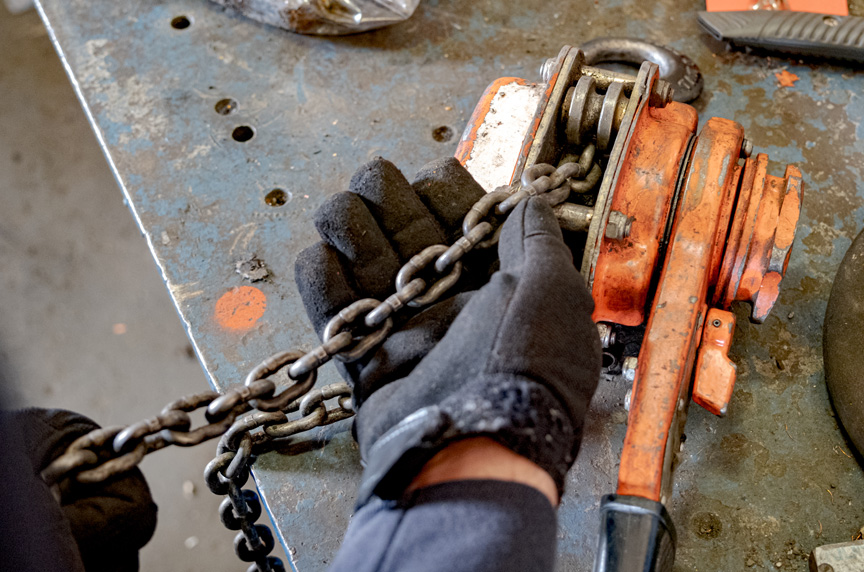Ratchet hoist inspection
The ratchet hoist is a fundamental component in lifting equipment and crane systems, critical to ensuring safety and reliability in industrial operations. Ratchet hoists are designed to provide secure and efficient lifting capabilities by allowing the load to move only when the ratchet teeth engage with the pawl mechanism. This system prevents slippage and ensures that loads can be lifted accurately and safely.
Inspecting a ratchet hoist involves thorough examination of its mechanical components to ensure they meet safety standards and operate efficiently. This inspection is vital for compliance with international standards such as ISO 4305, which specifies the design, manufacture, and testing of wire-wound lifting equipment. During an inspection, we evaluate critical aspects including:
- Functional integrity of the ratchet mechanism
- Mechanical wear on gears and pawls
- Condition of the load-bearing components such as pulleys and hooks
- Operational smoothness and absence of excessive friction or noise
The inspection process involves detailed visual assessments, functional testing, and sometimes disassembly for deeper analysis. Compliance with these standards ensures that ratchet hoists are not only safe to use but also perform optimally under various working conditions.
For quality managers and compliance officers, understanding the importance of regular inspections cannot be overstated. These professionals need to ensure that all lifting equipment meets safety requirements. For R&D engineers, inspection provides insights into potential improvements or modifications necessary for enhancing performance. Procurement teams rely on these inspections to make informed decisions about purchasing new ratchet hoists.
The benefits of a well-executed ratchet hoist inspection extend beyond mere compliance; it enhances operational efficiency and extends the lifespan of equipment. Regular inspections can identify issues early, preventing costly repairs or replacements down the line. By adhering to international standards such as ISO 4305, we ensure that our inspections are consistent with global best practices in the industry.
In summary, a ratchet hoist inspection is more than just routine maintenance; it's an essential part of ensuring safety and efficiency in industrial operations. This service plays a pivotal role in maintaining the integrity of lifting equipment, thereby safeguarding personnel and assets.
Applied Standards
The ratchet hoist inspection is guided by several key international standards that ensure the highest level of quality and safety:
- ISO 4305: Wire-wound lifting equipment—Design, manufacture, testing outlines the criteria for designing, manufacturing, and testing wire-wound lifting equipment.
- ASTM F2619-18: Standard Specification for Wire Rope Hoists and Winches provides specifications for wire rope hoists and winches, including ratchet hoists.
- EN 369: Safety of machinery—Wire-wound lifting equipment sets safety requirements specifically for wire-wound lifting equipment.
- IEC 60721-4-58: Electrical equipment and systems for industrial use—Lifting apparatus and cranes—Part 4-58: Ratchet hoists covers the electrical aspects of ratchet hoists in industrial settings.
These standards ensure that all inspections are conducted according to best practices, ensuring both safety and operational reliability. Compliance with these standards is crucial for maintaining high-quality lifting equipment that meets international safety requirements.
Scope and Methodology
The scope of a ratchet hoist inspection includes a comprehensive evaluation of all mechanical components to ensure they meet the specified criteria set by the relevant standards. The methodology involves several key steps:
- Initial Assessment: This step involves a visual examination of the entire hoist, checking for any visible damage or wear.
- Functional Testing: The hoist is tested under load to ensure it operates smoothly and without excessive friction. This includes testing the ratchet mechanism's engagement and disengagement, as well as the overall stability of the load.
- Detailed Inspection: Components such as gears, pawls, pulleys, and hooks are closely examined for signs of wear or damage. Disassembly may be necessary to conduct a more thorough inspection.
- Reporting: A detailed report is compiled, highlighting any issues found during the inspection and providing recommendations for repairs or replacements if necessary.
The methodology ensures that all critical aspects of the ratchet hoist are evaluated thoroughly. This approach not only meets but exceeds the requirements set by international standards like ISO 4305 and ASTM F2619-18, ensuring that the inspection is both thorough and reliable.
Environmental and Sustainability Contributions
The ratchet hoist inspection contributes significantly to environmental sustainability through several key initiatives:
- Economic Efficiency: By identifying issues early, inspections prevent the need for costly repairs or replacements. This reduces waste and extends the lifespan of equipment.
- Resource Conservation: Regular inspections help ensure that lifting equipment operates efficiently, reducing energy consumption and minimizing environmental impact.
- Reduced Carbon Footprint: By maintaining high standards of safety and efficiency, ratchet hoists contribute to a reduced carbon footprint in industrial operations.
- Eco-friendly Operations: Ensuring that lifting equipment operates at peak performance minimizes downtime and reduces the need for additional resources, promoting sustainable practices.
Through these contributions, ratchet hoist inspections play an important role in supporting environmental sustainability initiatives across various industries.





